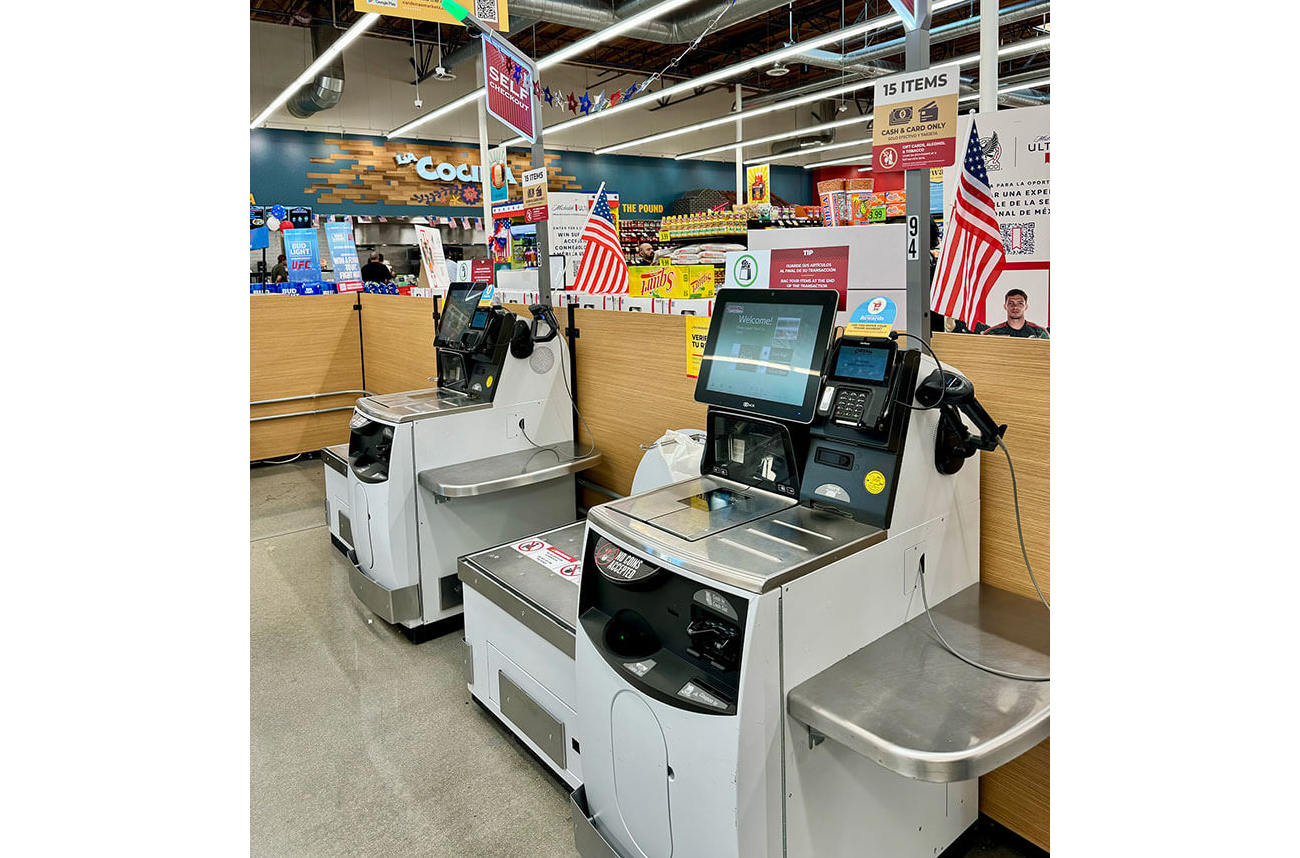Self-checkouts in grocery stores present both benefits and challenges for the retailers that utilize them.
In the benefits column, they allow customers buying just a handful of items to not get in a line behind someone doing two weeks’ worth of shopping. They also lessen the labor and eventually payroll burden for retailers, many of whom are struggling to find the front-end help they need. That’s a perennial struggle for many retailers but one that has increasingly plagued them since the COVID-19 pandemic.
On the challenges side, customers can, either through carelessness or intention, not pay for all their items. They also can largely avoid contact with the store’s employees, which is not necessarily a good thing. Direct contact with employees tends to deter stealing, and interaction with employees also can be an opportunity for positive relationship-building with customers. And some customers balk at using self-checkout as they don’t want to do a job they’re not getting paid to do or have any desire to do.

Prabash Coswatte, chief operating officer of Heritage Grocers Group, which operates 115 stores in six states in the western half of the U.S. under the Cardenas, Los Altos Ranch Market, Tony’s and El Rancho banners, confirmed the dual nature of the technology.
“Self-checkout systems offer a double-edged sword for customer experience,” he said. “While they empower shoppers to manage their purchases independently, bypassing lines and saving time, technical glitches and bagging challenges can lead to frustration.
“At Heritage, where exceptional customer service is a priority, we understand that convenience for one might be an obstacle for another. However, long lines are a universal pain point.”
He said that while it’s true that shoppers under age 35 are comfortable with and often use self-checkout to get through the line faster, his company is seeing older shoppers coming around.
“While there’s a generation gap in initial comfort with self-checkout, we’re seeing a positive trend,” he said. “Older adults who are willing to give it a try often find themselves preferring it in the long run. The key to success lies in having a patient and helpful attendant nearby.
“These attendants can answer questions, provide clear instructions and offer assistance when needed. With a little guidance, even those less familiar with technology can experience the convenience and speed that self-checkout offers. This approach caters to all customer preferences and ensures a smooth checkout experience for everyone.”
Each retailer, as is the case with all technology, must make the decision to offer or not offer self-checkouts based on their operational goals and realities.
Many shoppers seek SCO option
Though supermarket shoppers are mixed on their views of self-checkout, virtually all retailers have customers who want the option.
“Retailers who opt out of implementing self-checkout miss the opportunity to enhance the shopping experience for their customers and risk losing to the competition,” said Kara Watson, chief marketing officer for Truno, an integrated retail technology solutions company based in Lubbock, Texas.
Food Lion offers self-checkout lanes at several locations across its 10-state footprint
“We want our customers to have the flexibility to choose between traditional cashier-assisted checkout or self-checkout options,” said Troy Leshko, VP of retail services for the Salisbury, North Carolina-based chain that is a division of Ahold Delhaize. “We see positive responses from customers who appreciate the flexibility and convenience of checkout options.”
Publix Super Markets, a chain known for its high levels of customer service, began testing self-checkout in the early 2000s. By 2005, a dozen or so stores were offering it, and those numbers have continued to grow.
“We’ve continued to offer self-checkout over the years to meet the evolving needs of our customers. We currently offer self-checkout in more than 900 stores across our operating area,” said Maria Brous, director of communications for the Lakeland, Florida-based grocer that operates about 1,376 stores in Florida, Georgia, Alabama, Tennessee, South Carolina, North Carolina, Virginia and Kentucky.
[RELATED: Survey: Self-Checkout Adoption Among Retailers Rising]
HGG’s Coswatte said the company has 450 lanes currently deployed.
“We strategically place them based on customer preferences and demographics,” he said. “We carefully analyze customer demand for self-checkout and their comfort with technology to determine the ideal number of lanes for each location.”
HGG is fairly new to self-checkout. The results from a single pilot store in 2019 – which received “enthusiastic consumer reception,” he said – led to the rollout of self-checkouts to many more locations.
“To ensure a speedy checkout for everyone, we consider both customer preferences and store layout when deploying self-checkout stations,” Coswatte added.
“After analyzing demand for self-checkout and tech-savviness of our customers at a location, we strategically place between four and 12 lanes. We also factor in store traffic flow to determine if a single or double bank of self-checkout lanes would optimize the checkout experience.”
Opting out
Losses due to shrink have led Dollar General to remove or restrict self-checkout in most of its stores. And for some retailers, it just doesn’t fit with their operational model.
George Goodwin, whose family has its fourth generation of leadership at Goodwin’s Markets in Southern California, also operates Innovar Agency, which assists grocery stores with their marketing efforts. He said that for smaller independent grocers, “self-checkouts might not be the best choice, as customers values your market’s community feel and appreciate face-to-face interactions. You don’t want to jeopardize that connection.”
At the Goodwin and Sons Market in Crestline that reopened in May after a record snowfall collapsed the roof and the store had to be rebuilt, the company opted for a versatile solution – checkout stations that can be converted into self-checkouts.
He said the company had been cautious because some of the leading independents in the market have not adopted self-checkout, “which made us a little worried that we were trying to push too much innovation.” The store is in a tourist town with a population of about 15,000.
The convertible checkstands, six of them, allow it to offer cashier services or self-checkouts depending on customer needs or the store’s labor situation.
Super King Markets, an eight-store grocery operator in California, opts not to employ self-checkouts for a few reasons, according to Jake Fermanian, VP and member of the founding family.

“We never put self-checkout in our stores because we didn’t want to risk that shrink factor,” he said. “And we figured that from a customer experience standpoint, that interaction with the cashier goes a long way … And at the end of the day, we keep our service levels high in terms of available lanes.”
Super King stores also sell a high volume of produce items that are non-scanning, which would create issues at self-checkout. The store’s cashiers memorize the PLU numbers instead.
But, he said, “I completely understand the convenience for the customer, and there are definitely labor savings. But, unfortunately, for every retailer, there are those bad apples out there that tend to take advantage of self-checkout, or they might not even realize that [the item] didn’t scan.”

